Making an ultralight titanium pot stand for your alcohol stove
Posted: May 6th, 2012 by: h2
Today’s project is pretty easy. This is actually the second stand I made, the first was done in a similar manner, but used some old stainless steel bicycle spokes I had lying around. This project is a companion to how to make an alcohol stove priming tray article.

This stand when done will weigh 12,5 grams. The stove weighs about 15.5 grams. With thinner titanium, it would weigh a bit less. And yes, this stuff really works. The stove, stand, priming tray, and penny, weigh in at exactly 28 grams, just under an ounce that is. I carry an extra priming tray and penny, plus of course the windshield and pot and all that.
My entire solo cook set weighs in currently at about 10oz, that’s stove, stand, pot, pot cozy, 2oz alcohol fuel bottle, some condiments/containers and teas, and a spoon. For longer trips, I’d bring a soda bottle for more alcohol, carry that outside the pack of course.
When built in this way, the stand will support pretty much any pot made, from smallest to biggest, within reason of course. 2 liters at least anyway.
Stand Materials and Tools
-
The main component, some type of metal rod. You can get stainless steel bicycle spokes at most local bike shops. 15 gauge are fine, but make sure they are straight gauge, not the more normal 15/17. 16 gauge are also probably strong enough I’d say, and will be lighter, but are harder to find. You can usually buy these singly from quality bike shops. The steel they use in stainless bike spokes is very strong and hard to bend/cut.
For this project, however, a member of backpackinglight.com was nice enough to sell me some spare titanium rod he had available. Since selling the raw material isn’t his main thing (he sells his own pot stands, Zia, using a different design and method for construction) you’ll have to find your own sources if you want to use titanium.
The rods I used were 0.10 and 0.06 inch in diameter. I used the thicker for the two parts that actually hold up the pot, and the thinner for the connector piece that completes the triangle.
After seeing how the materials handled, I think a 0.08″ titanium rod would do quite well for all the legs, and would be solid enough for most pots.
- Two thicknesses of aluminum tubing. I got these from the hobby metals rack at Ace Hardware stores. Always support Ace Hardware, and other locally run and owned hardware stores please, plus Home Depot has zero clue about what you are talking about if you ask them for something like this. I took the rods I was going to use and selected the tubing inner diameter to get as close a fit as possible. Sometimes you may have to slightly flatten the tube to get both rods inserted, depends on the diameter of the rods. In my case, the 7/32″ (stock number 105) and 5/32″ (stock number 103) were perfect fits for two diameters of .1″ and .1 + .06″ respectively.
That’s it for the materials. Titanium is way easier to bend and cut than stainless steel bike spokes, by the way. I used a heavy set of pliers, a vice, and a hack saw to cut the thicker rod ends. plus a file to smooth off the cut ends.
Titanium also has a real positive side affect, aside from being sort of neat and hip, it cools almost instantly, making those burned fingers I’d get from touching the stainless steel pot stand a thing of the past. Steel holds the heat a lot longer. These things get hot by the way, very hot, red hot at times. To me that’s the real advantage of using titanium rod over stainless steel bike spokes.
I also made a template which you’ll see below that had all the key measurements on it to avoid error.
Dimensions
- Ground to top: 2.75″ (2 3/4″)
- Each leg width: 3.5″ (3 1/2″)
- Top bend in for pot support: 7/8″
- Support piece, without pot supports: 1 7/8″ high.
- Short leg, for sliding tube over: 1 1/4″
- Long aluminum main tubes: 1.5 (1 1/2″)
- Short, sliding tube: 1″
Note that the short tube must be short enough to be able to slide all the way over the short leg, but long enough to be stable and hold the legs together.
Adjust to fit your particular needs and stove.
Note that to fit my stove’s base, I have to bend the final triangle bottom into a partially circular form, you may not need that.
Note on using the same diameter rod for the stand
If you are not using different diameter rod like I am doing, for example, bike spokes, you should probably make each leg have one bend to hold the pot weight, the one slight flaw with the method I’m using here is that all the weight of the pot goes only onto two of the legs, the thin section only serves to stiffen and stabilize the two main weight supporting legs.
In that case, you’d make the long part of each section the same height, so that each section has one bended inwards top pot support, instead of one section having two in this example, and one one, and one none.
Making the pot stand
These pictures will walk you through the process, with brief explanation below each image.

First bend of the .1″ rod, with template, and the cut pieces of tubing. Note that the two longer tubes are 5/32″, and the shorter is 7/32″, but if you use the same sized rod / spoke for the entire project, you’ll use just one diameter of tubing.
The template is marked for the one big section that will have two pot stand bends in it when it’s done, the sliding part, that lets you take it apart, and the thinner brace piece that doesn’t really hold any weight, but just completes the triangle, the 0.06″ piece.
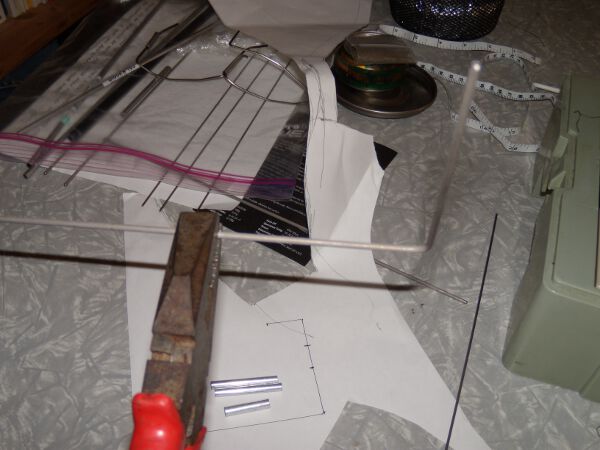
Second bend of the main support piece, 0.1″, this will have the two stand holder bends on top, so it’s going to be the longest piece used. The rods I got were 12″ long, bike spokes are about the same length, by the way.
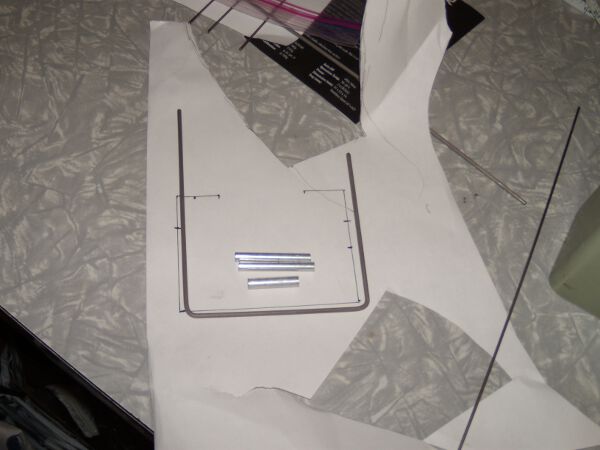
Bent, now to trim the longer leg so it’s the same length as the shorter one.
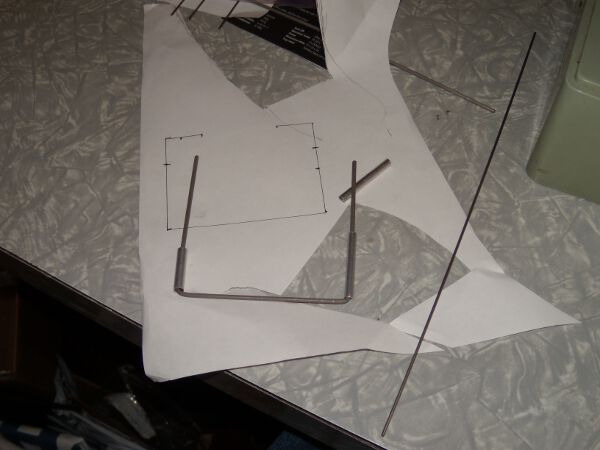
There it’s cut. I used a vice and a hacksaw, then filed the ends because while easy to bend, 0.1″ is still pretty thick and strong.
Trying the tubes on for size as well. It’s always a good idea to double check these things before it’s too late!
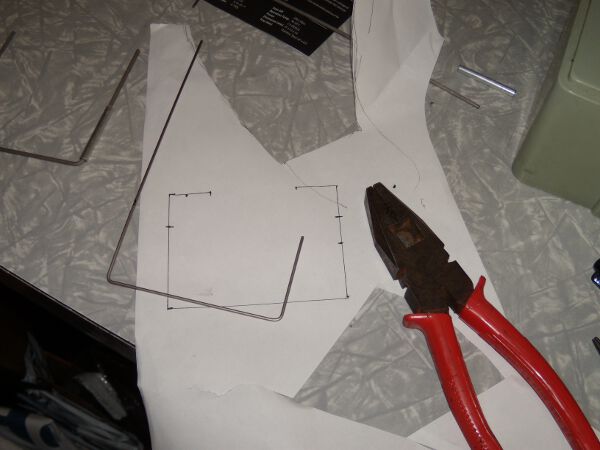
This is the thinner 0.06″ piece, this will be cut shorter, just about 5/16 or 3/8″ longer than the top of longer tubes when the pieces are put together, as per the dimensions above. We’ll bend the ends to make the entire unit not fall apart in the next step.

Insert the thinner piece into the two longer tubes after bending both ends slighty, but not so much you can’t slip them through the tubes. This will lock it in place once the other rods are inserted. Note that I bent the ends inward, not outward, this is important or the pieces aren’t free to open and close once it’s all together.
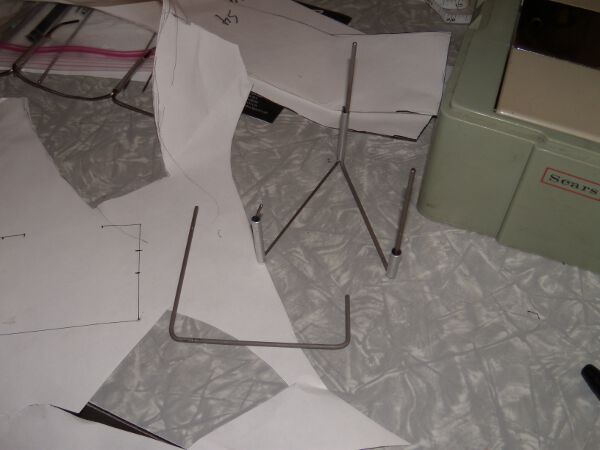
This is the second 0.1″ thick piece, note that it’s shorter on one side, that is going to be the side that the shorter tube goes over. The shorter tube has to be short enough so it can slide over this short end, freeing the triangle for collapse and storage.

There you see the pieces all together, through the tubes. Next step is to bend the tops, this will lock all the parts in place, so it doesn’t fall apart. Make sure it’s all right at this point. The height of the bend we’ll make depends on the stove you use.
I’m using a penny stove (those are the directions for how to make one, don’t try to improve on the design, he’s very good at what he does), which wants about a 2 3/4″ ground to pot height. This particular stove is made for a narrow pot, with 5 jets pointing in, and 1 pointing out, to create the required heat for vaporization. For wider pots, you use all the jets pointing out. Sadly, I didn’t take picture of the stove making process. Penny stoves are not easy to make but are very efficient.

Now I had to bend slightly the bottom triangle to fit the base of the penny stove, forming a sort of semi-circle, I used two bends in each leg to form that fit. If your stove fits nicely inside it, you don’t need to add those bends, unless your windscreen is narrow.
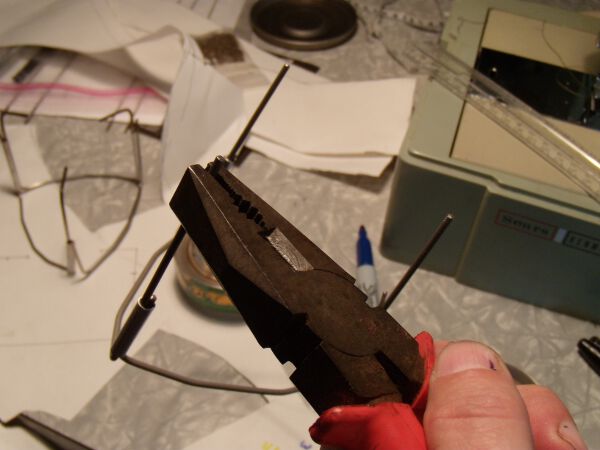
Now it’s time to add the top bends, those are the ones that will hold the pot itself. Some people say to just put the pot on the ends, and not bend them, but that’s not very stable compared to this method in my opinion.
That’s the old bike spoke pot stand to the left, by the way.
The top bends are the trickiest part of the procedure by far, I found that if you mark at 2.75″ inches (2 3/4″), then put the pliers right at that mark, and then bend downwards, the pliers holding the end that will be bent in, it comes out about right, but it’s sort of hard to redo this bend, so you might want to practice it on some scraps first.
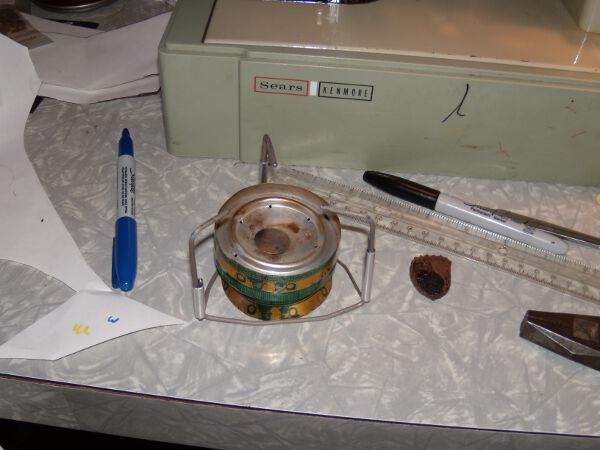
There’s the penny stove, its base, and the pot stand, all ready to go! The stand weighs with these thicknesses of titanium, 12.5 grams, a bit less than 1/2oz. The stainless steel version weighs about 17.5 grams. The stainless steel is also much stronger, by the way. But the titanium is plenty strong.

There’s the leg detached. You detach it by sliding up the shorter tube, up the leg, freeing the shorter rod end.
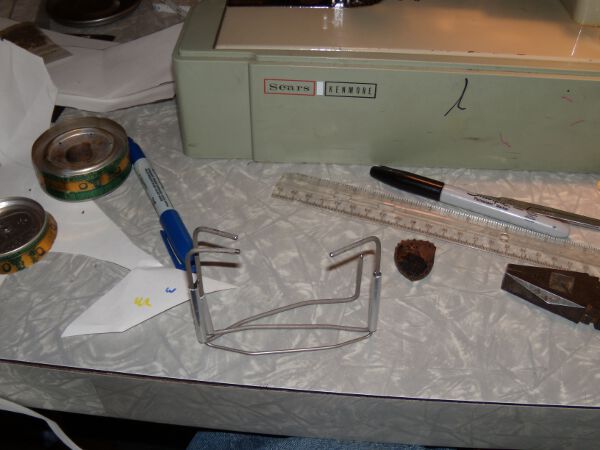
There’s the stand folded up, ready to be stored away.
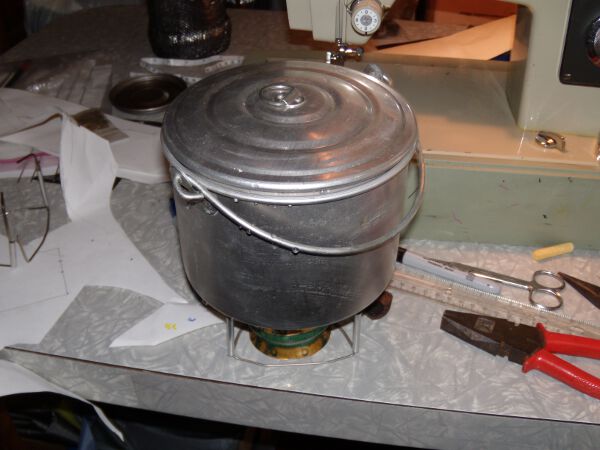
Of course I had to test this, so I took a big aluminum pot, about 2 liters, and filled it with water, total was about 4 pounds. Stand was solid, no wobble, I’d trust that in the field, even though my pot is much smaller.
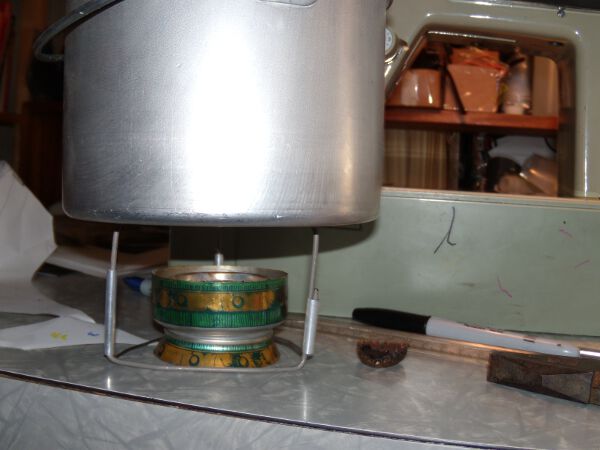
That’s what the finished product looks like, pot, pot stand, and stove. The windscreen would go around that, of course.
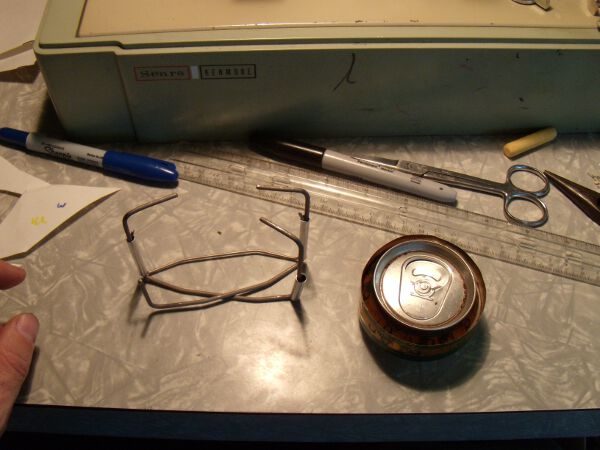
Pot stand and stove ready to be packed away.
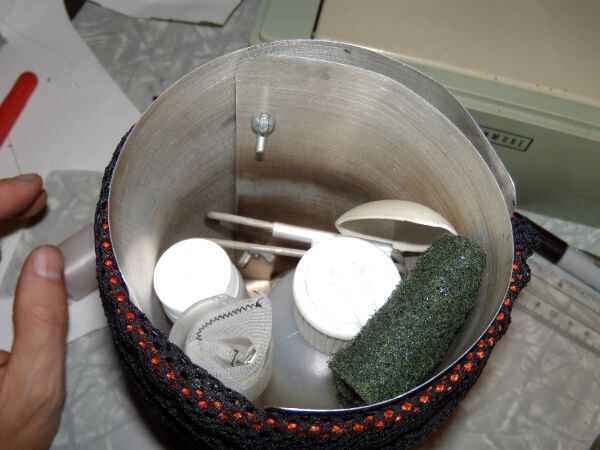
There’s the folded up pot stand in my pot, which is about a 900 ml pot I think, holds a bit more than 3 cups anyway. The pot holds my entire cooking kit, plus the windscreen.
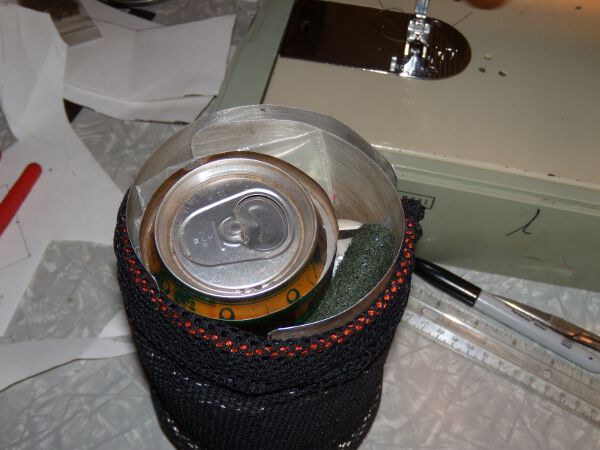
The stove goes on last, on top.

And then it’s all closed up, I’m replacing that orange cord/cord lock, they are very heavy, with some ultralight ones. (update: I replaced the orange cord with a nice slim polyester cord and micro cord lock, that in total weigh probably 1 gram, compared to the 5 grams of the orange cord and big cord lock. Same exact functionality and just a slight bit less durable).
In case you’re wondering, that’s my reflectix pot cozy and cozy lid that the pot is in, that helps with keeping the heat in when you are rehydrating or cooking food after you take it off the heat.
And that’s that. All done.
Projects like this are easy, and might make you wonder just why you needed that overpriced fancy Jetboil thing that gives you zero flexibility in terms of handling different pots. Plus there’s just something nice about using something where you can say to yourself, yep, I made that, and it works fine.